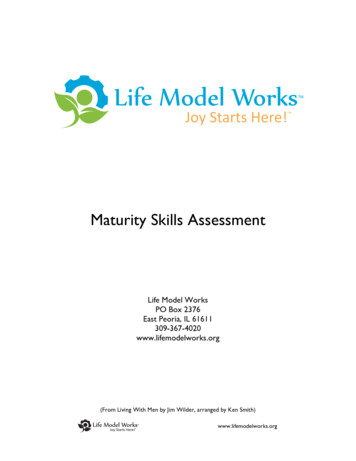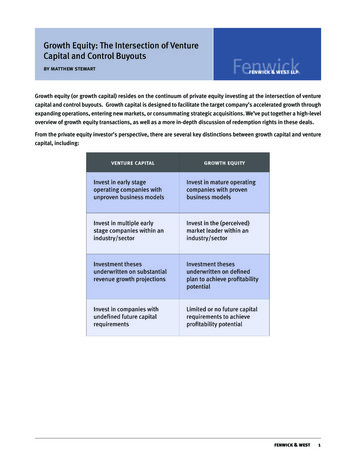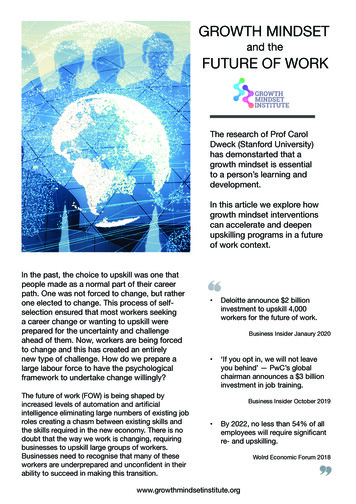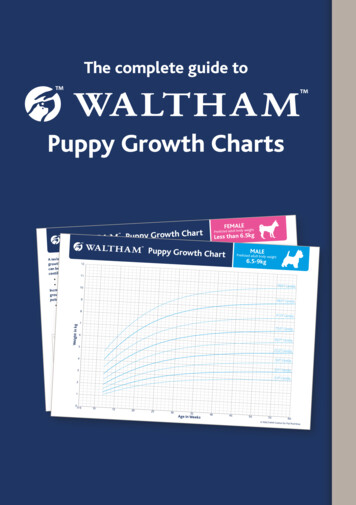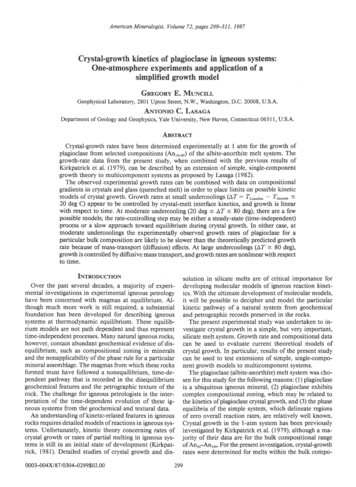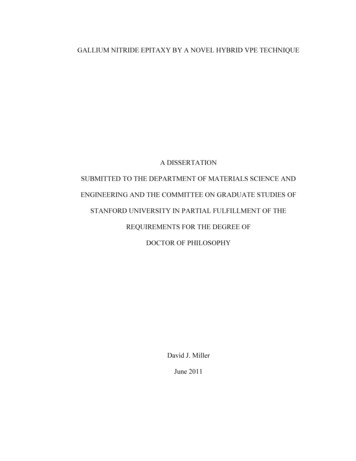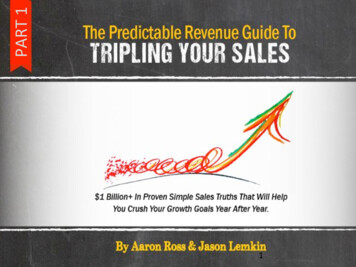
Transcription
1%PART%1%
2%You Can Crush Your Growth GoalsThe world’s filled with sales advice. Some great,some harmful, mostly outdated or ‘nice’.‘Nice’ is helpful if you want a 30% bump. But what if you want a300% increase? It happens more often and more systematicallythan you may realize.If you care about sales for your team or company, here are a fewPRACTICAL, REPEATABLE ideas that have been proven tomake a HUGE difference in sales.As in a 100 million difference.Or going public & selling for 1 billion.Or “only” doubling or tripling sales.At a minimum, this ebook can help give you more peace of mind,predictability and clarity in how to make next year the best yet.These Ideas Helped Salesforce.com almost doubleenterprise revenue and add 1 billionto its topline revenues.EchoSign and the Adobe DocumentServices grow from 0 in revenue in2006 to 144 million in ARR in 2013.Responsys transform from a slowgrowth 20 million business torocketing 10x to 200 million inrevenue in 5 years, and being sold toOracle for 1.5 billion.Acquia (a 45 million company) toadd an extra 12- 15 million thisyear AND make sure it is “when, notif” it will break 100 million inrevenue.
ecBng%Drop'Sales'Team'Churn'To' 10%'Make%your%sales%team%scalable%
ing%author%of%Predictable Revenue: Turn Your Business Into A Sales Machine With The 100 Million Best Prac?ces Of Salesforce.com extra% %signature%service.%%Jason%led%it%from% 0%to% 100%million anything%having%to%do%with%Hawaii.%
5%Bigger,%Beaer%This ebook highlights powerful nuggets from the forthcoming sequel to the#1 best-seller Predictable Revenue.This ebook you hold contains highlights from the forthcoming full book,“The Predictable Revenue Guide To Tripling Your Sales,” a sequel toPredictable Revenue.The “Triple” book builds on the original with more case studies, moredetails, more apps, and more ideas as you’ll be able to see here.
6%Select%Ideas%From%Predictable Revenue (1/3)%Lead generation drives fast growth, not the size of your sales team.If you haven’t read PredictableRevenue or it’s been awhile, here’sa short summary of select keyideas.What Drives Rapid Growth?Thinking that adding salespeopleand working them harder is whatdrives sales growth remains acommon fatal mistake withexecutives & investors.Lead generation drives growth;salespeople fulfill it.If you have predictable, scalablelead generation, you can createpredictable, scalable revenue.Salesforce.com added an extra 100 million in revenue in its earlyyears (and by now 1 billion),almost doubling growth, by creatinga dedicated prospecting teamfollowing a “Cold Calling 2.0”process.Why Salespeople Shouldn’tProspect1. Experienced salespeople hateto prospect.2. Experienced salespeoplearen’t any good at prospecting.3. Even if a rare salespersonprospects successfully, theybecome busy closing, and stopprospecting consistently. It'snot sustainable.
7%Select%Ideas%From%Predictable Revenue (2/3)%80% of the time, better & more predictable lead generation is the key tounlocking faster, predictable growth.Specialization Is Your MultiplierProspectors should prospect,closers should close.Specializing your sales roles is thesingle most important thing youcan do to improve everything.The Four Core Sales Roles:1.2.3.4.Inbound Lead QualifiersOutbound ProspectorsSalespeople/AccountExecutivesAccount Managers &Customer Success ManagersThis ebook will have more detailson specialization in the section,“Your #1 Sales Multiplier:Specialization.”On Scalable Growth”Work harder" and "make morecalls" doesn’t scale. Don’t blindlydo more of what’s not working – fixthe systems first, then put moreenergy into them after they’reworking correctly.Great lead generation fixes a lot ofsales problems.Of course you only want to hireonly great people, but the betteryour lead generation is, the lessdependent you are on the quality ofyour salespeople and salesprocess.You can have the most perfectsales process in the world, but ifyour lead generation lags, you willstruggle.Conversely, you can have a terriblesales process, but still do very wellif you have great lead generation.
8%Select%Ideas%From%Predictable Revenue (3/3)%Want new salespeople to ramp FAST? Create pipeline/leads for them towalk into. And promote from within as much as possible.By promoting from within using afarm team system to developtalent, you reduce your "hiring risk"of new people because your talentalready knows your products andcustomers, your culture, yoursystems and they've alreadyproven themselves - or at least youalready know the truth about theirstrengths and weaknesses.On Outbound Prospecting / ColdCalling 2.0The outbound prospecting role isoften treated within a salesorganization as a low-level, cheapjob. If you treat it that way, you’llget low-level, cheap results.A dedicated prospecting team witha successful process (which isn’t“make 100 dials a day”) is a verypredictable way to create leads.And if you can create predictableleads, you can create predictablerevenue.Hire hungry, coachable people (nottoo much sales experience), trainthem on your products andcustomers, and give them asystematized process and they canoften generate all the appointmentsyou need.Sales ManagementTraditional cold calls wereineffective at Salesforce. But anemail-based approach, usingsimple text-based emails asking forreferrals, generated 7-10% initialresponse rates & was wildlysuccessful.A sales team can only grow to theextent that top leaders (CEO, VPSales) aren’t needed to bring in orclose deals.Give your sales team the option tohelp create team goals & systems –even helping design their owncomp plans – and you can getbetter results & more buy-in.
9%Which%Apps%Maaer?%%%%The original Predictable Revenue barely touched on useful sales &marketing apps.Since the book came out, the number of neatsales & marketing apps has grown by one or twobazillion.It can be overwhelming. There are hundredsand thousands of useful or interesting apps. Andmany individual sales reps have found some ofthem helpful.But which ones can make a difference acrossyour entire team in repeatable, scalable ways?Well, there are a LOT of great apps that canwork for you that way, but here are a few to startwith
10%Which%Apps%Maaer?%Some apps mentioned in the coming case studies:Cirrus Insight: If you use both Gmail &Salesforce.com, run - don’t walk - to get this app thatlets you update Salesforce from within Gmail.LeadGenius: An innovative outsourced prospectingservice that helps in a small number of focused ways(rather than trying to do too much).Gainsight: A Customer Success Managementapplication to help teams more easily track &increase revenue with higher retention and upselling.SalesLoft: A fast-growing favorite app salespeople &prospectors use to build targeted, high-quality lists(with emails & phone #’s) from LinkedIn.Hoopla: The #1 sales motivation app making it easyto excite inside sales teams into scoring more wins.Showpad: A tablet / smartphone app for fieldsalespeople, whether they’re visiting enterprises,small businesses or manufacturing plants. Tabletschange everything for the field!InsightSquared: An easy-to-use Sales Analyticssolution that offers actionable insights into yourleadgen & sales metrics to improve decision-makingon how to triple your sales.NewVoiceMedia: Cloud contact center solution thata) accelerates lead follow-up for sales, and b)personalizes customer support & customer successin Salesforce.Yesware: A sales acceleration tool that helps youunderstand what activities equal closed business bytracking and analyzing email communications acrossGmail and Salesforce.com.
11%To%Grow%Faster,%Hope%Must%Die%How many reps or managers count “maybes” or longshots to get them to quota every period? You know,the deals that always “could” happen? Hope canmake you blind to seeing what is and isn’t workingor not; you need a reality check to make gooddecisions.For example, the app InsightSquared helps teamsreach ‘the truth’ more easily and sell smarter with livecharts.This “Sales Strikezone” chart makes it easy fora rep or manager to zero in on just a few of their bestopportunities to focus their precious time as the monthor quarter gets closer to the end.
or%Growth:%%“Seeds, Nets & Spears”%
13%Lead%GeneraBon%Absolves%Many%Sins%Have any of these problems? More than 20% of yoursalespeople missing quota Sales turnover 10% Low close rates Slow sales cycles Demotivated salespeople Missed 2 quotas in a row Bad breath (just checking tosee if you’re still reading )Rather than chasing piecemealsolutions like trying to improveyour demo process, hiringapproach and Salesforce.comsetup (though all are important),more often than not, there is “onething to rule them all” – betterlead generation can solve a lot –or most - of your salesproblems.When you struggle generatingenough decent leads for yoursalespeople, everything elseneeds to be perfect.You need perfect salespeople.You need a perfect sales process.You need a perfect product.Because you have no buffer to getanything wrong.A bigger, better lead generationmachine (whether from inbound,outbound, whatever) gives you a lotof slack to get a lot of things wrong– and yet still crush your goals.You can have a perfect salesprocess, but without scalable leadgeneration systems, you can’thelp but struggle.(It’s not just the amount of leads –you need quality leads.)With great lead generation, youcan get pretty much everythingelse wrong, and still do reallywell.There are the three basic types ofleads that you need to understand.
ars”%The best way to triple new salesisn’t by tripling your salespeople(the traditional method) – but bytripling your qualified leads.You can have the most amazingsales process in the world, but ifyou’re not getting enough leads,you’re going to struggle.You can have a Ferrari car, but itdoesn’t move an inch without gas.If you have a crummy salesprocess, but excellent leadgeneration, you’re going to do well!LEAD GENERATION IS YOURGASOLINE FOR GROWTH.Yes - you do need a great productor service and some happycustomers, but that’s not enough,and none of that matters if youcan’t proactively drive leadsfrom both new prospects andcurrent customers.3 Types of Lead Generation:Seeds, Nets & Spears1) “Seeds” are many-to-manycampaigns; they’re based onword-of-mouth andrelationships. For mostcompanies, this mainly will be yourhappy customers who generatereferrals, high renewal rates, andhigh upsell/cross-sell rates.Salesforce.com pioneered the“Customer Success Management”services approach to systematizethis. Happy customers beget morehappy customers, and are yourbest source of long-term revenuegrowth and high profitability.
ars”%2) “Nets” are one-to-manymarketing campaigns, withapproaches like ‘inboundmarketing’ and ‘growth hacking.’Hubspot and Marketo are twocompanies that have pioneeredthe whole inbound marketingindustry.One is not better than anotherToo many companies obsess on asingle form of lead generation andignore the others.To build a house you need multipletools: a hammer, a saw and ascrewdriver. Know why, how andwhen to use each tool.3) “Spears” are targetedoutbound prospecting orbusiness development, ideally bya dedicated prospector(s). The“Cold Calling 2.0” outbound teamand process at Salesforce.com hasadded more than 1 billion inrecurring revenue to companies,including Salesforce.com andResponsys.Each type of lead can havedifferent marketing funnels,conversion rates, sales cycles,average deal sizes, ideal targetcustomers and methods ofincreasing them.The important thing is knowingwhich type(s), and in what mix/balance, work best for yourbusiness.
16%Lead%GeneraBon%Type%#1:%Seeds%
17%What%You’ll%Learn%In%This%SecBon%Customer Success is NOT free help, glorified supportor an afterthought! The pros & cons of “Seeds” (word of mouth) leads, and the bestway to systematize their growth What it takes to make Customer Success a C-Level function (onpar with sales & marketing) 6 keys to driving growth with Customer Success Why you’re underestimating your Lifetime Customer Value by50% How Gild dropped customer churn from 3-4% to 1% per month 5 Ways Topcon provides predictably excellent customer service
18%Lead%GeneraBon%Type%#1:%%“Seeds”% %Customer%Success%Customer Success is not about increasing customer satisfaction, butcreating revenue growth.All the great work you do to helpothers succeed & buildrelationships is “planting seeds” –whether they’re employees,partners, investors or customers.It’s getting what you want byhelping get what they want. Soyou can succeed and feel good atthe same time.Pros & Cons of “Seeds”What “Customer Success” Isn’tPros: Highly profitable, word ofmouth leads are the fastest to closeand have the highest win rates.There’s nothing better!Customer Success is not free help.It isn’t glorified customer support.And like sales, it should be arevenue driver, not cost center.Cons: It’s almost impossible toproactively grow them.Customer Success begins as amindset, at the CEO level, ontargeting, creating product for andservicing the kinds of customers thatneed your product.How To Grow Seeds - Predictably“Seeds” is word-of-mouth leadgeneration. Which is notscalable or repeatable, exceptwhen you have a methodical wayof making customers successful &documenting it (“CustomerSuccess”).The best way to methodically growyour Seeds is with a dedication toCustomer Success, which reducescustomer churn, increases upsells,increases referrals & improvesmarketing content.The future standard for executiveteams will include a head ofCustomer Success who’s on thesame level as the heads of sales,marketing & demand generation.
19%Lead%GeneraBon%Type%#1:%%“Seeds”% %Customer%Success%Turn your funnel into an hourglass – how does Customer Success create revenue?Executives need to understand thatCustomer Success is not about increasingcustomer satisfaction, but creatingrevenue growth.With an executive focus on CustomerSuccess, you will see:Lower Churn: The easiest revenuecomes from keeping the customers youhave.More Revenue (New Business &Upsells): More referrals to newcustomers; more willingness to try & buyyour other offerings .Better Marketing: You can improveeverything in lead generation & sales withdetailed case studies and testimonials.
20%When%Does%95%% %Failure? Your Goal: “Negative Revenue Churn”Do you retain 95% of your customers month-to-month?Rules of Thumb In Saas:That’d be something to be proud of, until you do the math.“Customer Churn” (or “LogoChurn”) of 15% or less per year(just over 1% per month.) This isbased on the number of customerswho leave.That’s 5% churn per month, or 60% per year. In other words, youhave to replace 60% of your revenue every year just to breakeven.What if you have monthly 98% retention / 2% churn? That’s still25% a year, or a quarter of your revenue.The best-run companies can see up to -2% churn per month (on arevenue basis). Yes, that’s NEGATIVE 2% which means theymake more money every month.HOW?Because the customers who stay with them buy & spend moreover time than the company loses from other customers leaving.“Revenue Churn” of 0% or lessper year. The customers who staybuy enough new licenses or productto cover revenue losses from thecustomers who left.
ss%(1/3)'If you’re a CEO, you need to take“Customer Success” as seriouslyas marketing, sales or productdevelopment.1. Customer Success Is YourCore Growth DriverAll great companies’ customerscome from one main source –Word-of-Mouth whether the leadcomes via referral directly, orwhether new customers are closedwith case studies, references ortestimonials.This is much more measurable inrecurring revenue models, wherewe can track renewal rates, upsellamounts & referrals.2. Customer Success Is 5x MoreImportant Than SalesYes – sales is critical. But sales isonly there at the very start of therelationship. And to repeatedlyclose new customers, sales needsCustomer Success resources – likereferences.Generally, founders do a good jobof doing whatever it takes to get abig deal closed – but often a poorjob of everything after that,because they’re off to help with thenext fire, drama or Big Deal.CEOs and founders – don’t focuson getting new customers in somuch that you ignore your currentcustomers. Get on planes to visitcustomers as well as prospects.3. Start Early, Hire EarlyIn Saas companies, a rule of thumbis having one Customer SuccessManager per 2m in revenue –hired in advance of that revenue,not after you have it.Silicon Valley companies withenough funding often now investbig at the beginning, with 2-4people on the team right away.Remember, a Customer Successperson, like a salesperson ormarketing budget, is an investmentthat should make you (a lot) ofmoney, not just a cost to be put offas long as possible.
(2/3)'Jason’s 5 2 rule on this:* Every cofounder, the CEO, plusevery Customer Success Manager,* Must meet onsite with 5customers a month (that’s 60 peryear), and* Get 2 customer badges everyyear as a bonus (that is – you visitso often to warrant a badge.)4. Visit Customers In PersonUnhappy customers don’t (always)complain before they leave. Inperson visits can make all thedifference in surfacing problemsand in changing their attitudes.A phone call is not a meeting. Byvisiting in person, regularly, yourcompany will learn more aboutwhat’s really working and not, earnmore trust, and those customerswill (almost) never churn. It’s muchharder to tell a friend you’re leavingthem than some faceless company.What if I have nothing to say? Justshow them your roadmap, and askfor feedback on it, and on issuesthey are having today. That alonewill fill the meeting.5. Customer Success NeedsFinancial Responsibility &MetricsWhen your Customer Successfunction doesn’t have financialgoals, it’s value can get muddled.One bad assumption is that “agreat product will automaticallycreate happy customers,” and youwon’t need to hire people toactively work with your customers.However easy or incredible yourproduct is, you need humanstalking to select categories of yourcustomers.(Continued on the next page )
(3/3)'5. Customer Success NeedsFinancial Responsibility &Metrics ( continued fromprevious page). The whole point of CustomerSuccess is to increase “NetNegative Churn,” so you needtools & processes to measure andimprove the function, includinghow the people on your teamperform.To justify investment (such as inheadcount or tools) by a company,plus create the hunger a CustomerSuccess leader and team need todeliver measurable results,Customer Success needs to ownsome financial results: usually atleast a) retention rates &perhaps even b) upsell revenue.6. Evolve Customer SuccessGoals & Metrics As You Grow(Source: Gainsight)i. Traction ( 0- 1m) – What docustomers want, and what do theydo with our product?For example, at Gild (a case studycoming on Page 27) CustomerSuccess owns:1.2.3.4.“90 Day Adoption”Feeding usage data &customer feedback into theproduct roadmapRenewalsUpsellsAnd it makes it easy for theexecutive team and board to seeexactly how the Customer Successfunction’s contributing to Gild.ii. Adoption ( 1m- 5m) – Why andhow should customers include ourproduct in their daily business?iii. Retention ( 5- 20m) – Why docustomers need to keep on usingour product after the honeymoon?iv. Expansion ( 20m- 100m) –Why should customers expand tomore seats, more features?v. Optimization ( 100m ) –Automation & improvements drivenby data.
(The%Magic%of%Customer%Success%Revenue)%Everyone in SaaS talks aboutCLTV: Customer Lifetime Value;also known as LTV. (I try to avoidacronyms, but sometimes I justgotta use 'em).You can see a detailed analysis ofhow to calculate Lifetime Value byDavid Skok at Saas Metrics 2.0.And then, everyone goes on tocalculate some magic metric tellingyou how much to spend on Salesand Marketing, usually somefraction (1/3 or so) of your CLTV, orabout the first year's worth ofrevenue from a customer. Soundsfine, so long as you have themoney to fund it.The problem is that this doesn’t gofar enough. Standard CLTVcalculations don’t account forvirality and "second order"customers - the ones that come inlater, from the first customerreferring their friends.In other words, your average CLTVshould be higher because the firstcustomer should get extra credit forhelping bring in their friends to yourcompany.By underestimating the value of acustomer, you may underinvestoverall in acquiring them. Or more commonly - you invest toomuch in Sales and Marketing andnot enough in Customer Success.Total Lifetime Revenue From ASingle Average SaaS Customer:Ok Sales closes its averageEnterprise Customer A for 10,000a year. Nice.Then, in Year 2, average EnterpriseCustomer A adds 2,500 inadditional licenses, for 12,500total in Year 2.Then in Year 3, they add another25%, or 15,625 total.So: direct revenue over the firstthree years 38,125 from thatFirst Sale.Now most customers last longerthan 3 years, but let’s stop there fornow 24%
(The%Magic%of%Customer%Success%Revenue)%Now: Second Order Effects* At the end of Year 1, yourchampion quits EnterpriseCustomer A, but goes to EnterpriseCustomer B to do the Exact SameJob. And buys your product again.(This happens about 10% of thetime.)* So that first sale is actually worth 42,000 (that first 38k above x110%). But then it happens againin Year 2. So it’s really 46,000.* And at the end of Year 1, yourchampion tells three of her friendsabout your company. And one ofthem purchases. (About 30% ofthe time.)So the first sale is actually worth 60,000 with the second orderrevenue - if you’re making yourcustomers super duper happy.So your “all-in” CLTV, includingsecond-order revenues, could be2x your current estimate.So sure, figure out the perfect ratioof Sales and Marketing costs toCLTV to share with your board.Because the second order effectscompound. This is where “Seeds”becomes a growth driver. They’reessential to fast, profitable growth.
mples of Customer Success triggers & alerts Use Data To Know Who ToReach Out To, When & WhyMost Customer Success efforts stilluse a lot of guesswork and manualreporting. But get your data acttogether, perhaps manually at firstand later with a product likeGainsight, you can get a fuller lookat each customer:- Contract data: e.g., customersnot expanding, stagnating, renewalor key dates coming up- Support interactions: e.g., lots oflow priority tickets or customersthat have stopped calling- Billing / payment history: e.g.,delayed invoices due to frustration- Product and feature usage: e.g.,which features are sticky and who'susing them- Marketing engagement:unsubscribing to newsletters- Survey feedback: e.g., bad inputfrom key person- Sponsor changes: e.g., execcontact leaves, new CMONow, data can’t warn you of everyproblem. You will always needhumans talking to humans touncover & resolve issues.But this data will help you:1. Develop triggers for when tointervene proactively before badstuff happens. Obviously it’s easierto save a customer before theysend you a canceling notice! Firstthe team does this based uponintuition, and over time it can bebased more and more on historicaldata and automatic triggers/alerts.2. Standardize interventions sothat each Customer SuccessManager is using the same set ofbest interventions, and with thisconsistency you can bettermeasure the effectiveness of eachintervention or type of problem /solution.26%
27%How%Gild%Dropped%Monthly%Churn%From%4%%To% 1%%%(1/3)%Gild is helping companies betterrecruit engineers, by using dataavailable on the web (includingdevelopers’ actual code) to helpmeasure their abilities.Brad Warga’s the SVP CustomerSuccess there. He joined whenthere were just 5 people: CEO,CTO, CSO, head of sales & headof marketing (now there’s 50 ).Brad had been in HR/recruiting for20 years, including recently beingthe VP of Corporate Recruiting atSalesforce, helping organize &execute thousands of hires.The team wasn’t exactly sure whatBrad would do at first, but they felthe could bring a lot of credibility,and he did. First, he helped bringin new customers.After The First Year Of SellingDuring most of the first year ofselling, Brad helped bring in newcustomers, until there were about50. Churn was artificially low –aseveryone was on annual contracts!When the contracts began comingup for renewal, churn jumped to3-4% a month, or 30% per year;2-3x their target.Churn Goals: “15% & 0%”Saas companies want:1) 15% or less churn per year ontheir total number of customers, &2) 0% or negative revenue churn(upsell revenue from ongoingcustomers should exceed revenuelost from leaving customers).Gild starting measuring andanalyzing churn, and realized manyof their assumptions were wrong.For example, it turned out that howoften people logged in wasn’t agreat way to tell who would stay orgo. Gild actually needed to look atwhich parts of the product werebeing used, and how. How savvywere the users? What were theirrecruiting needs and methods?
28%How%Gild%Dropped%Monthly%Churn%From%4%%To% 1%%%(2/3) What Gild assumed would help spot churn - such as how often userslogged or didn’t log in - was wrong.By digging into these root causesof churn, Brad & Gild were able tosystematize customer success anddrop churn to 1% per month.(And – it made Gild much smarterabout targeting the right kinds ofcustomers from the very beginningwith lead generation.)The Three Methods ThatDropped Churn:1. “90 Day Adoption”The Customer Success team’srelationship with a customer startswhen the customer purchases theproduct and it’s turned on.The team trains the new users howto use the product, what the bestrecruiting practices are, and resells / re-evangelizes Gild to theusers to get them excited.Gild found out that if there’ssuccessful usage of the product inthe first 90 days, then usage will be3x higher for the rest of the yearcompared to a customer who didn’tadopt fast.2. Quarterly Business ReviewsThese “reviews” are formal andhelp hold the customer accountableto what they signed up for. Ideally,they’re onsite with the rightcustomers.3. Using Predictive ToolsGild’s main Customer Successapplication is Gainsight, along withZendesk (captures trouble ticketsand feature requests),Salesforce.com, and Olark er&year?”''
29%How%Gild%Dropped%Monthly%Churn%From%4%%To% 1%%%(3/3)%Four functions Customer Success owns at Gild: a) 90 Day Adoption, b)roadmap feedback, c) renewals, & d) upsells.Team CompositionThe Gild Customer Success (“CS”)team has about 10 people acrossthree roles (out of 50 employees!):1) “Inside CS reps” who train,monitor usage & run analytics.There’s one rep per 70 users.2) “Outside CS reps” who handle &are measured on renewals. Thereis one rep per 30 users in theirrelevant customer segment.3) “Executive CS reps” who areresponsible for upselling, and whowork mostly with the larger or fastgrowing customer segment.These teams’ main app isGainsight, which also displaysSalesforce.com & Zendesk data, soeverything’s in one interface.The Gainsight reports &dashboards make it easy to spot atrisk customers or customers whoneed more product, and gives repsa reason to call a customer to talk.C-Level Customer SuccessA lot of companies treat customersuccess as an afterthought, orglorified customer support.Companies need to treat it (atleast) as important as sales ormarketing.At Gild, Customer Success owns:1. 90 Day Adoption2. Feeding usage data &customer feedback into theproduct roadmap3. Renewals4. UpsellsBy owning these and being able toclearly articulate them, it’s easy forthe board to recognize the value ofCustomer Success there.
hy%Turn Customer Success metrics/alerts into Dashboards to cut guesswork(Source: Gainsight)
%Service%(1/3)%Frustrated Customer Support agentsHelp create frustrated customers.Customer Support (like sales orsales prospecting) doesn’t have tobe a burnout, boiler-room job.Why are the two teams thatinteract with customers the most(sales, support), so commonlymistreated or unappreciated?That needs to change, sincefrustrated agents (& salespeople)help create frustrated customers.Topcon Positioning Systems (partof the 1 billion / 4,000 employeeglobal Topcon Corp.) is the world’slargest developer & manufacturerof yes, positioning sys
“The Predictable Revenue Guide To Tripling Your Sales,” a sequel to Predictable Revenue. The “Triple” book builds on the original with more case studies, more details, more apps, and more ideas as you’ll be able to see here. This ebook highlights powerful nuggets from the forthcoming sequel to th
